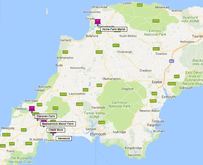wildlife
|
Treraven farm is made up of a variety of habitats and is a haven for wildlife. Our site management aims to improve the site's wildlife value over time and we want to involve expert partners and volunteers in that process. You can see images of Treraven and its wildlife in the gallery |
species
|
habitats
|
|
Reptiles and Amphibians
People have seen lizards, slow worms, grass-snakes, frogs and toads at Treraven; mostly in the hay meadows and adjoining woods. |
The salt marsh meadows
These were drained circa 1800, and then re-flooded for wild-life habitat and to aid flood prevention in 2006. During the 1950’s and 1960’s the drained flood plain was used for summer autocross racing, car racing on grass. |
|
Birds
Many people enjoy bird watching at Treraven, especially looking out over the salt marshes at water birds, or watching barn owls hunting over the hay meadows at dusk. In late spring Will Delacour leads a dawn chorus bird-song walk, teaching how to recognize birds by their calls and flight patterns |
New woodlands and orchards
The new woods on the borders of the open-access hay meadows contain diverse species and were planted in 2002. They need thinning and coppicing, and other forms of management to improve their value as wildlife habitat. A small fruit orchard with plums, apples and other fruit was planted near the top of the hill in 2015 and there are plans for more orchards in time. |
|
Butterflies and moths
Nearly 200 moth species have been identified on summer mothing nights at Treraven; 68 in a single night in 2014. , and we are yet to assemble a list of butterflies at the site. So far, we are yet to assemble a list of butterflies at the site and even less attention has been paid to surveying other types of insects, though ground-dwelling beetles have been surveyed as part of a student ecology dissertation.
|
Old native woodland
Mostly on steep slopes on the edge of a stream and estuary, these are a mixture of beech, ash and oak, with an understorey of hawthorn, gorse, holly and brambles. Bluebells, wood anemones and wild garlic brighten the woodland floor in the spring and early summer. Farmland and meadows
Treraven is subject to a Higher Level Stewardship Scheme. The majority of the land within the scheme is managed by low intensity cattle grazing with low inputs. Facilitating public access and education are also key elements. | ||||||

